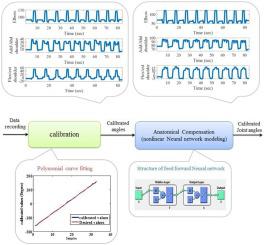Sensors and Actuators A: Physical ( IF 4.6 ) Pub Date : 2020-06-26 , DOI: 10.1016/j.sna.2020.112170 Mahdie Khaliq fard , Ali Fallah , Ali Maleki

|
The reliability of electrogoniometers as wearable sensors depends on the biomechanical characteristics of the human body. The major causes of electrogoniometric measurement errors are the complexity of movements and the anatomical features of joints. Accordingly, the main objective of this study is to enhance goniometric measurements of body kinematics as a dynamical form of calibration method. In this case study, an experiment was designed in the reachable workspace for gathering joint angles and modeling the related information among them, so a nonlinear neural network was established to compensate the goniometric measurement errors with mapping angular variations simultaneously. The results can be confirmed that the proposed method compensated measurement errors. According to the mean absolute error (MAE) criterion, the results indicated up to 4.5 cm difference between the desired and estimated values of target positions in a reachable workspace and elucidated the significant effect between the desired and estimated 3D target positions before and after using the proposed method. Consequently, since the electrogoniometer has been limited to measuring variations of joint angles separately, the most striking result to emerge from the present study is that the proposed method copes with the finding relationship among measurements of upper extremity kinematics to compensate the goniometric measurement errors.
中文翻译:

上肢运动学的电动测角法中生物力学误差的补偿
电动测角仪作为可穿戴传感器的可靠性取决于人体的生物力学特性。电测角法测量误差的主要原因是运动的复杂性和关节的解剖特征。因此,本研究的主要目的是增强人体运动学的角速度测量方法,作为校准方法的一种动态形式。在此案例研究中,在可到达的工作空间中设计了一个实验,用于收集关节角度并对其之间的相关信息进行建模,因此建立了一个非线性神经网络,以同时绘制角度变化来补偿角度测量误差。结果可以证实所提出的方法补偿了测量误差。根据平均绝对误差(MAE)准则,结果表明,在可到达的工作空间中,目标位置的期望值和估计值之间相差最多4.5厘米,并阐明了在使用建议的方法之前和之后,期望的3D目标位置和估计的3D目标位置之间的显着影响。因此,由于电子测角计仅限于分别测量关节角度的变化,因此从本研究中得出的最显着结果是,该方法可以应对上肢运动学测量之间的发现关系,以补偿角度测量误差。


























 京公网安备 11010802027423号
京公网安备 11010802027423号